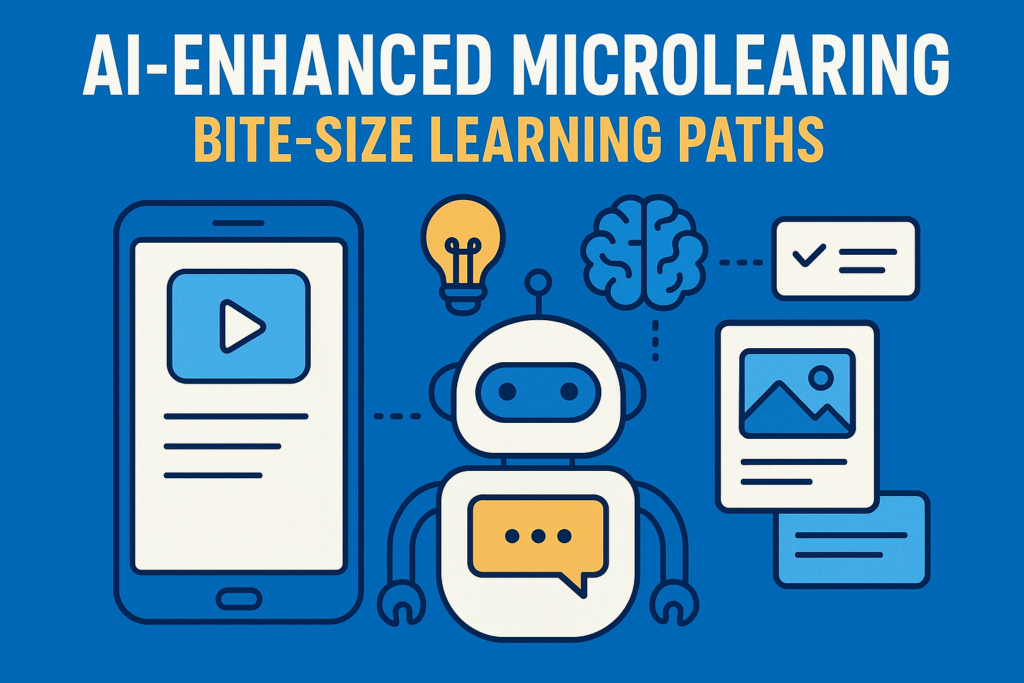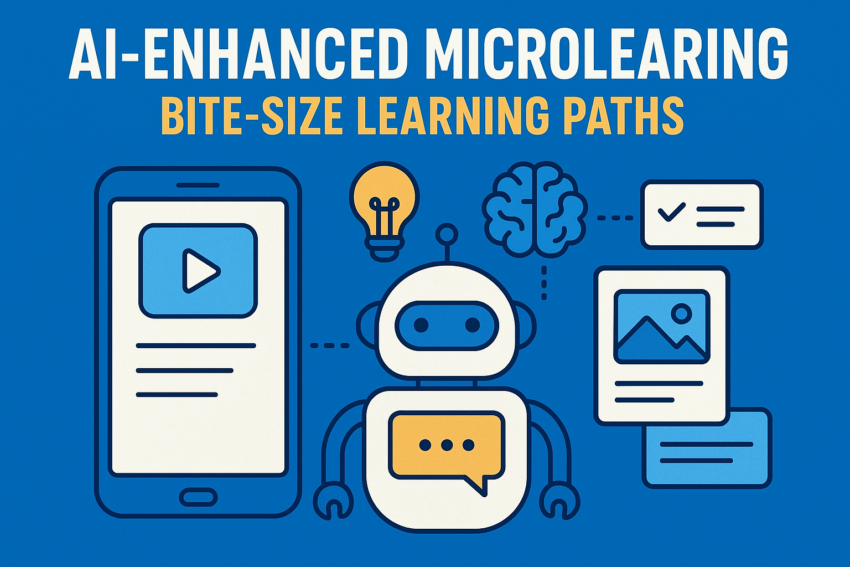🎯 Introduction: The Age of Short Attention Spans
In today’s world, attention is the new currency. From 30-second reels to 2-minute podcasts, learners now want quick, focused knowledge that fits into their tight schedules. Traditional 1-hour lectures and bulky e-courses are losing ground to something smarter — Microlearning.
Now, with the rise of Artificial Intelligence (AI) tools like ChatGPT, this concept has evolved into something even more powerful:
👉 AI-Enhanced Microlearning — short, personalized, dynamic lessons that adapt to every learner’s pace and style.
This blog explores how AI is transforming microlearning, why it works so well, and how it can reshape the way we learn forever.
💡 What Is AI-Enhanced Microlearning?
Microlearning means breaking down information into small, easy-to-digest modules (usually 2–5 minutes long). These can be videos, flashcards, quizzes, infographics, or quick summaries.
Now, when we add AI to the equation, the process becomes more powerful and adaptive.
AI tools can:
- Automatically generate bite-sized lessons from long articles or textbooks.
- Create personalized quizzes to test what you’ve just learned.
- Offer instant feedback and improvement tips.
- Track your progress and adjust future lessons accordingly.
In short, AI transforms static learning into an interactive and evolving experience.
🤖 How AI Makes Microlearning Smarter
Let’s look at how AI enhances microlearning in practical ways:
1. Automatic Content Generation
AI tools like ChatGPT, Gemini, or Claude can summarize chapters, create flashcards, or explain complex ideas in simple language.
Example: Upload a 20-page research paper, and AI will turn it into:
- A 3-minute summary
- 10 quick-fire flashcards
- 5 quiz questions
All within seconds.
2. Adaptive Learning Paths
AI continuously analyzes a learner’s performance — what topics they master quickly and where they struggle. Then, it automatically reshapes the next set of lessons.
👉 If you’re weak in “Machine Learning Basics,” the system can slow down, offer examples, and quiz you more on that area before moving forward.
3. Natural Language Interaction
AI chatbots act as personal tutors. Instead of watching a video passively, you can ask the AI:
“Explain this formula again using a real-life example.”
The AI responds immediately — like a human teacher available 24/7.
4. Gamification and Engagement
AI can gamify learning with badges, leaderboards, and streaks. It tracks your motivation and rewards your consistency, making the learning process fun and habit-forming.
5. Multimodal Learning
AI can generate not just text, but also images, audio, and video lessons based on your preferences.
Prefer listening while walking? AI converts lessons into podcasts.
Visual learner? Get an infographic summary.
🧠 Why AI-Enhanced Microlearning Works
1. Fits Modern Attention Spans:
According to studies, the average attention span of Gen Z learners is less than 8 seconds. Bite-sized lessons cater perfectly to this behavior.
2. Just-In-Time Learning:
You can learn a skill or concept right when you need it — for example, revising “Data Structures” 10 minutes before an interview.
3. High Retention Rate:
Short lessons help the brain retain more information. When combined with AI-based repetition and spaced learning, the retention can jump by 60–70%.
4. Personalized Pace:
Everyone learns differently. AI ensures no one is too fast or too slow — your lessons adapt to your rhythm.
5. Continuous Feedback Loop:
AI monitors your learning journey, identifies weak points, and keeps adjusting — something traditional systems can’t do.
📱 Real-World Applications
Corporate Training:
Companies use AI-powered platforms to train employees through 5-minute daily modules instead of long seminars.
Example: A sales team gets daily AI-generated micro-lessons on new product updates.
K-12 and Higher Education:
Students can use AI to break textbooks into micro-topics and test themselves before exams.
Skill Development Platforms:
Apps like Duolingo and Coursera are already integrating AI to provide personalized micro-courses, keeping users hooked through gamified learning.
Self-Learning and Productivity:
Individuals use tools like ChatGPT, Notion AI, and Quizlet AI to learn small skills every day — from coding syntax to marketing trends.
🔍 Challenges and Risks
Every revolution has its challenges, and AI-based microlearning is no different.
- Over-dependence on AI: Learners may skip deep understanding in favor of quick summaries.
- Data Privacy Concerns: AI systems need data to personalize content — ensuring privacy is key.
- Content Accuracy: AI sometimes generates inaccurate or biased information. Verification is essential.
- Human Touch: Emotional and motivational guidance from human teachers can’t be fully replaced.
🌏 The Future of Learning: Personalized, Mobile, and AI-Driven
The future classroom will not be confined to walls or fixed schedules. Imagine this:
- You wake up and your AI tutor sends a 3-minute “learning snack” based on your career goals.
- It quizzes you on yesterday’s lesson, tracks your sleep-learning pattern, and adapts today’s content.
- By the time you finish your coffee, you’ve mastered a new concept.
That’s the AI-enhanced learning revolution — learning that’s fast, personal, and lifelong.
AI won’t replace teachers — but it will empower them. It will make education accessible to millions who couldn’t attend traditional systems.
🏁 Conclusion: Learn Less, Learn Smart
In a world overflowing with information, the key isn’t learning more — it’s learning smart.
AI-Enhanced Microlearning is not just a trend; it’s a necessity for the modern learner. It makes education faster, flexible, and truly personal.
Whether you’re a student, teacher, or professional, start using AI tools to break your learning into daily micro-steps.
Remember — five focused minutes today can change your tomorrow.
Table of Contents

